

Get a grip - relevancy for your sport
Danny M O'Dell gives tips on this often-neglected area of strength training.
Imagine the following scenario:
- You have carefully prepared your athlete for the major competition.
- He is stronger now than ever before.
- He is about to pull a personal best in the final deadlift of his group.
- The bar comes off the floor, and you know in your heart of hearts that it will fly up to the top…but suddenly it drops out of his hands.
What happened? How can he be so strong yet not be able to finish the lift? Well, it may have to do with his grip strength or lack thereof. If he can pull, but not hold onto the bar, then there is an identified problem that needs correcting. Many sports require above-average hand strength. How well your athlete can control the torque of the tennis racket as a ball hits the strings, throw the hammer, handle the oars in rowing, or hold onto the shaft of the pole vault all depend on your athlete's ability to provide adequate power in maintaining their grip in a superior manner.
The following article illustrates a slick device for increasing your hand strength; a list of different grip exercises follows it. It will be left up to you as a coach to incorporate these movements into your athlete's developmental program.
Grip strengthening exercises
The accompanying photographs (Fig. 1-3) show a great device for developing your grip. Each piece of PVC tubing fits into the next larger one. The diameter of the handle can be made larger or smaller depending on the level of difficulty desired. Naturally, the smaller the handle, the easier the task of holding onto the resistance. Once the handle becomes over three inches in diameter, the ability to grip and lift becomes problematic. Slowly adapt your strength with each successively larger diameter handle.
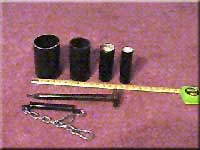 Fig 1 |
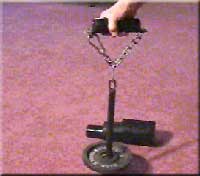 Fig 2 |
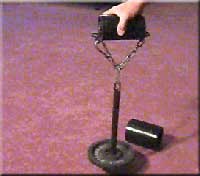 Fig 3 |
Not only are these handles useful for simple lifting exercises, but they can also be adapted to the pulley, band, or elastic modes of resistance training as depicted in fig. 4 and 5. Also, the larger-sized handles make chin-up and pull-up exercises much more difficult to accomplish.
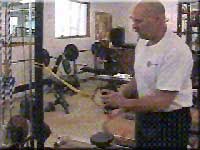 Fig 4 |
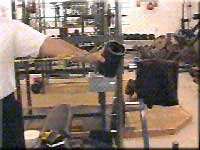 Fig 5 |
Additional ideas to develop your grip strength
Newspaper Crunching
- Start with one full newspaper sheet and crunch it up into a ball with one hand.
- Progress to more and more sheets of newspaper and make each of the increased layers into the smallest ball possible.
Rubber ball squeezes
- Begin with a small toy ball or squash ball.
- Squeeze the ball for twenty-five repetitions three times.
- Use a tennis ball for the same progression as above.
Rubberband stretches
- Place a rubber band around the fingernails of one hand, spread the fingers apart, hold the stretch, relax, and repeat. Increase the number of bands as your strength develops.
Additional exercises
- Bar hangs for time.
- Weight added bar hangs.
- Paper book rips.
- Towel twists.
- Medicine ball squeezes with both hands.
- A weighted bag holds for time or distance.
- A weighted bag is held while vertical jumping and maintaining the grip.
Exercises with a Thor's Hammer
The Thor's hammer is an adjustable dumbbell with plates added to one end only. Sledgehammers can be used in place of the dumbbell, but minor adjustments of weight are easier if the dumbbell is used. Begin holding the bar near the weight until you build up the strength to use the lever of the full handle.
- Hold the non-plated loaded end as you would a hammer or in a handshake or neutral grip position at the sides of your legs. The dumbbell plates will be facing forward with the bar horizontal to the ground.
- Move the bar/weight down and up using only wrist action.
- The next movement is with the plates to the rear, again the motion down and up using only wrist action.
Begin the development of your grip strength by working on your endurance first, then go to a strength-based program that employs heavy weights coupled with low reps.
Article Reference
This article first appeared in:
- O'DELL, D. (2004) Get a grip - relevance for your sport. Brian Mackenzie's Successful Coaching, (ISSN 1745-7513/ 12 / May), p. 8
Page Reference
If you quote information from this page in your work, then the reference for this page is:
- O'DELL, D. (2004) Get a grip - relevancy for your sport [WWW] Available from: https://www.brianmac.co.uk/articles/scni12a6.htm [Accessed
About the Author
Danny O`Dell is an NSCA Certified Strength and Conditioning coach from the USA. He is the author of several training manuals, including The Ultimate Bench Press Manual, Wilderness Basics, Strength Training Secrets, Composite Training, and Power Up Your Driving Muscles. Danny has published articles in national and international magazines describing the benefits of living a healthy, fitness lifestyle.